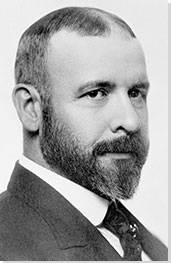Summary of Louis Sullivan
Louis Sullivan pioneered modern design principles in North America, designing buildings that grew from and for the changing commercial needs of the urban and rural Midwest. Sullivan's buildings were both economical and beautiful, with streamlined forms and decoration that emphasized their purpose. He is known primarily for the creating a form for skyscrapers, office buildings that pushed upward rather than outward, that highlighted their verticality and for the strength of his decorative work, which highlighted the underlying form of buildings and introduced Art Nouveau to North America. Sullivan's style of architecture influenced those working around and for him, with both the Chicago School and the Prairie School developing from his work, and his emphasis on beginning a design for a building with that building's purpose in mind guided architects working across the twentieth century.
Accomplishments
- Sullivan's work was guided by the adage that "form follows function," a phrase for which he became known. He believed in looking at the purpose of a building before devising an architectural form for it and in ensuring that usage was reflected in both the structure and the decoration.
- Sullivan was known for the high quality of his decoration, which he used to emphasize the structure of buildings and unify disparate components rather than to distract from structure. He regularly repeated motifs, particularly semi-circular arches, and used materials that could serve as decoration rather than requiring additional ornamentation. He used twisting, organic motifs on terracotta facades and in ironwork, pioneering Art Nouveau in the United States.
- Sullivan drew from earlier precedents. He reconceived the classical column as a basis for a skyscraper and created Romanesque portals that elevated commercial buildings. This innovation had a significant impact on American architecture; his vertical designs created the form from which most skyscrapers evolved, while his buildings with horizontal emphasizes created a distinctive architecture suited to the flat American Midwest. This introduction of classical elements into the modern architectural vocabulary was continued, later, through the Interwar Classicism movement.
Important Art by Louis Sullivan
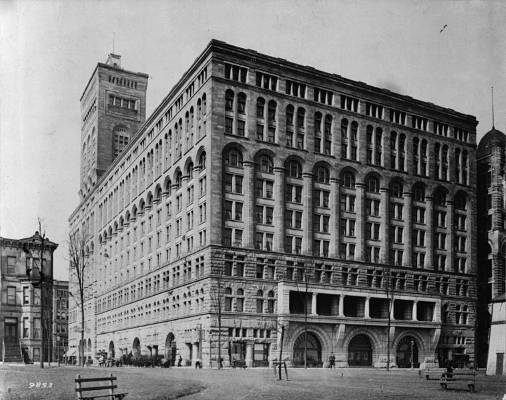
Auditorium Building
The Auditorium Building was the largest building in the United States and the tallest in Chicago when completed in 1899. The structure housed a theatre, hotel and offices, with the entrance to the auditorium on the south side; this auditorium, fronting onto Michigan Avenue, was surrounded by 136 offices and a 400-room hotel, arranged into a uniform ten-storey building. This was embellished with a square tower, with an additional eight storeys, above the entrance to the auditorium, offering views over Lake Michigan. The Chicago Auditorium was particularly striking, externally, when buildings of this size were uncommon. It made a strong visual impression through the heaviness of the rough stone and through its ordered symmetry, with the height emphasized through the unembellished arches above the windows. Inside, the arch motif is repeated in the theatre's proscenium arch and ceiling, which is highly ornate, and the barrel-vault of the hotel's restaurant.
This project was a collaboration between Sullivan and Adler, with the assistance of engineer Paul Mueller. The building is based on H. H. Richardson's Marshall Field Warehouse, which adapted the Romanesque style to suit a modern commercial building, but sets itself apart through innovative engineering and interior embellishment. The foundation of the building operated like a raft, built from crisscrossed railroad ties with a double layer of steel rails embedded in concrete, allowing the building to stand on a site where soft blue clay made conventional foundations impossible. This raft also served to distribute the weight of the load-bearing outer walls over a large area.
Sullivan's contribution to modern ornament can be seen in the repetition of the arch motif on the façade and within the auditorium itself, which allows decoration without compromising simplicity and the overall integrity of the building. His French training is also clear, with the curvilinear motifs throughout the theatre's interior providing an American equivalent to the plant-based decorative systems developing as Art Nouveau in Europe at this time.
Chicago, Illinois
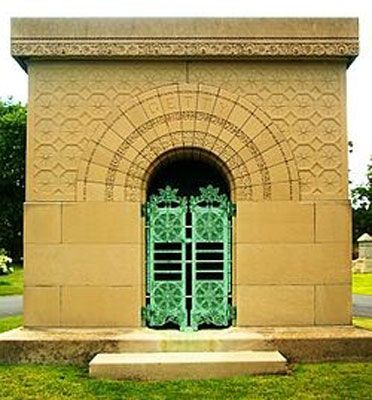
Carrie Eliza Getty Tomb
This Tomb is one of three mausoleums that Sullivan designed in Chicago's Graceland Cemetery. This, the most significant of the three, was commissioned by Henry Harrison Getty after the death of his wife, Carrie Eliza Getty, and intended to serve as a tomb for the pair. The tomb stands on a triangular plot and takes the form of a square prism. The structure is composed of limestone, which are arranged in large, regular blocks on the lower half of the tomb. The upper half is more decorative, with a regular pattern of octagons, each of which contains a starburst design. The cornice features a band of smooth limestone above another with an intricate spiral pattern and the roof above is flat. Approaching the tomb, the visitor's focus is drawn by the ornate bronze gates at the center, over which is a semi-circular arch composed of wedge-shaped voussoirs with bands of ornament and engraved letters spelling 'GETTY.'
This mausoleum marks a clear departure from earlier funerary monument traditions along with clearly illustrating Sullivan's approach to ornament. This structure rejects the figurative sculpture and gothic features that distinguished nineteenth-century tombs, instead embracing pared back decoration that consists largely of geometric forms. Sullivan's use of a limited palette clearly articulates the structure of the tomb, with the bronze entrance drawing the visitor's focus, connected to the stone walls above through the repetition of the starburst motif on the gates. Sullivan's use of curvilinear forms, particularly on the gates, can be linked to Art Nouveau, but the use of simple, geometric decoration in order to accentuate form, rather than obscuring or embellishing it, proved influential in movements including the Prairie School and, later, Interwar Classicism.
Chicago, Illinois
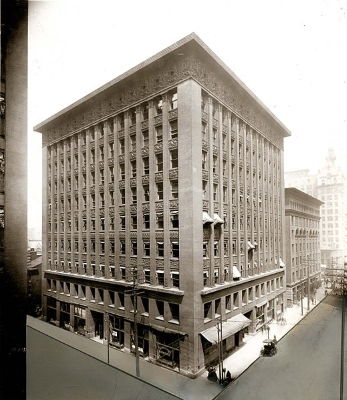
Wainwright Building
The Wainwright Building, a nine-story office building with a terracotta façade, is Louis Sullivan's first skyscraper and one of the most influential buildings in the United States. The base of the structure contains retail stores with wide windows; above the second floor is a simple cornice that separates the lower floors from the grid of identical windows above. The supporting piers are designed to appear as pillars, drawing the eye upward and emphasizing the verticality of the structure. While the terracotta at street level is plain, the windows above the second floor are separated by carved inset terracotta panels and the building finishes with a frieze, carved with celery leaf patterning, and overhanging cornice, beyond which is a flat roof.
While the Wainwright Building was not the first skyscraper to be built, it was the first to define the form, creating a modern visual language for the new building type. Prior to this, skyscrapers were designed following Beaux-Arts rules, with an aesthetic emphasis on horizontal bands rather than unified vertical facades. Sullivan's design for the Wainwright Building took advantage of steel-frame construction, recently developed, to create a façade without masonry, emphasizing the revolutionary engineering through design that emphasized its new possibilities, reaching toward the sky.
The Wainwright building is dominated by its vertical lines, with windows and horizontal panels inset so as to make the piers leading upward more pronounced. Sullivan's overall conception of the building is similarly based on the structure of a classical column, with a simple yet weighty base giving way to a plain shaft and ending with an ornate attic, though the specifics of his detailing is resolutely modern, with plain terracotta on the lower floors and the celery leaf used as the basis for the decoration of the frieze.
Sullivan's insistence on a vertical aesthetic drew from his tenet, "form follows function," which would come to dominate modern architectural approaches. The Wainwright Building was highly influential; almost every skyscraper designed over the following quarter-century borrowed directly from Sullivan's approach, as can be seen in Daniel Burnham's Flatiron Building (1902) and Holabird & Roche's Brooks Building (1909-10). In Chicago, particularly, Sullivan's approach was widely adopted, resulting in a skyline that appeared uniform and coherent when seen from a distance.
St. Louis, Missouri
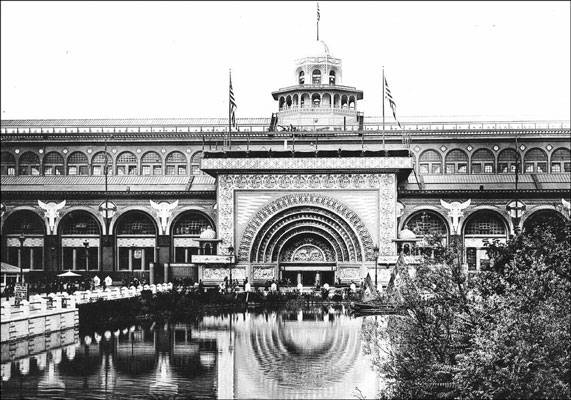
Transportation Building
The Transportation Building was a temporary pavilion, housing locomotives, railway cars and other transport exhibits, designed by Louis Sullivan for the World's Columbian Exposition in Chicago, Illinois, in 1893. The structure, which faced the Court of Honor, was an eighteen-acre shed lined with arcades and lit through clerestory windows and a cupola at the center of the roof which could be reached via an exhibit of elevators. The façade of this shed was covered with linen angels, glued to the exterior, each holding the name of a famous inventor, and painted in red, blue, green and gold. The central entrance, painted pea-green with silver leaf embellishment, came to be known as the "Golden Door." This was a large Romanesque portal, with five arches embellished with bas-relief and mural painting above three square doors. The arches were framed by a large rectangular border.
The nature of the event meant that the structure had to be cheap and quick to produce, capable of rapid construction and decoration, whilst making a strong visual impact on visitors and enclosing a vast amount of interior space for display. Other architects working at the World's Columbian Exposition had largely responded to the brief with ivory buildings that drew from classical precedents, for which the event would come to be known as the "White City," but Sullivan instead drew inspiration from both the Romanesque and from nineteenth-century European industrial architecture, creating a building that stood out at the fair.
While the classical structures had a strong impact on the American Renaissance Revival, Sullivan's Transportation Building offered an alternate direction in which architecture could move. His unique style is recognizable, particularly in the portal, which echoes the interior of the Chicago Auditorium in its arches, and the building led to an exhibition of Sullivan's work in Europe, where it was popular. Despite the speed and low cost with which the building was erected, Sullivan's interest in the relationship between structure and decoration is clear in his use of color, which was used in order to emphasize the form of the building, with separate components painted in different colors.
Chicago, Illinois

Guaranty Building
Sullivan continued to develop his approach to office buildings during the 1890s and the Guaranty Building in Buffalo, New York, quickly became one of the city's early landmarks of modernism. On the ground floor, the windows are large and there are entrances, with an arch above each, on the two facades with street frontage. There is a cornice, above the second level, that runs around the building, and above this is a grid of vertically-oriented windows, inset and divided by piers that run to the top of the building, where round windows allow light into the attic and emphasize the way in which the upper cornice curves outward into an overhang.
This was the last project built by Adler & Sullivan before the firm disbanded, though it is unclear whether Adler himself worked on the building with Sullivan. The Guaranty Building is structured and designed similarly to the Wainwright Building, with a steel frame and terracotta façade, but is more ambitious in both height and decoration. It showcases Sullivan's signature semi-circular arches, which are used to shape entrances, frame windows and in the richly detailed interior, unifying disparate aspects of the design. Similarly, the building offers an excellent example of Sullivan's "form follows function" ethos in action, with the use of different sections of the building reflected in the design. At the base, a plain and wide-windowed area provided space for shops, while the offices above were delineated through vertical ribbons of masonry which rose to a cornice, perforated by round windows and covered in stylized vines, where mechanical equipment, such as elevator motors, were housed.
Buffalo, New York
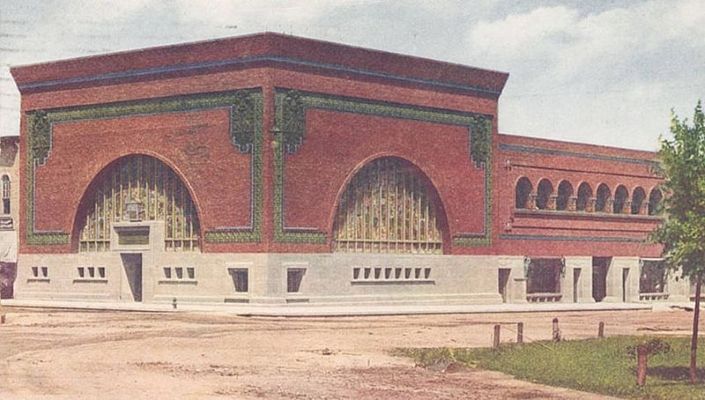
National Farmer's Bank
After the dissolution of Adler & Sullivan, Louis Sullivan, with the assistance of George Elmslie, built a large number of bank branches across the Midwest, the first of which was the National Farmer's Bank in Owatonna, Minnesota. The National Farmer's Bank, like the other branches known as "jewel boxes," is built in brick. The building is a simple but imposing rectangle of two storys, built on a corner, with single-story wings extending along the street in either direction. The entrance level façade is terracotta with small square windows and a door with a boxy frame, while the second story is dominated by large semi-circular windows, both of which are framed by green terracotta panels arranged in a rectangle with arched windows in each corner, filled with blue and green mosaics, set against the brick. At the top, the building is crowned by a heavy cornice, while a skylight allows additional light to reach the interior.
Sullivan was chosen for this commission due to his reputation as an architect who could create buildings that not only fulfilled the practical needs, but also expressed the use to which the structure would be put. Sullivan's attention to the needs of the bank is clear in the arrangement of rooms, which were specifically allocated and included a women's consultation room, a conference room for the board, an office for the bank's president and an exchange room for farmers. The elaborate mural by Oskar Gross, ornate lighting fixtures designed by George Elmslie and range of custom furniture inside these rooms gave dignity to the activities performed within the regional bank.
This structure, simpler than the skyscrapers for which Sullivan is more widely known, also show clearly his influence on the Prairie School of Architecture; the bank emphasizes horizontal rather than vertical lines and has a striking flatness despite the richness of decoration. The vibrancy of the bank building provided a style that met the needs of the Midwest and encouraged greater development of an architecture that celebrated the particularities of the region, providing townspeople with a structure of which they could be proud.
Owatonna, Minnesota
People's Savings and Loan Association Bank
The People's Saving and Loan Association Bank, built in 1911, is the second of Sullivan's 'jewel box' banks and the last of his projects on which George Elmslie worked. Sullivan's initial design for the bank was rejected, due to cost, and this subsequent structure, with reduced terracotta decoration, was conceived with an emphasis on interior rather than exterior, with the large banking room designed first and the surrounding rooms and facades developed from this. The banking room features a skylight and clerestory windows, below which are brick and marble counters. At the southern end of the room, a sheet of plate glass positions the polished steel door to the bank vault, behind it, as a decorative element. The simple exterior, derived from the shapes of the interior, is built with fifteen different shades of brick, creating the decorative impression of a woven rug.
This bank is compact, but rich in design, showcasing Sullivan's skill as an interior decorator and his innovative use of materials. There are strong horizontal lines throughout, a defining feature in the Prairie School architecture over which he exerted a strong influence; the central room is long and narrow, with horizontal bricks, beams of oak and narrow marble counters that reinforce this. The space's decoration largely comes from the use of materials, with the interplay of different textures creating visual interest, though the natural light is diffused through the use of stained glass. Sullivan's influence is particularly clear in examining the interior of the People's Saving and Loan Association Bank alongside the domestic architecture of Frank Lloyd Wright, which similarly emphasizes horizontality through interior decoration; his interior also anticipates the spaces of Ludwig Mies van der Rohe, which eschew ornament in favor of a range of luxurious materials.
Sidney, Ohio
Biography of Louis Sullivan
Childhood and Education
Louis Sullivan was born in Boston in 1856, the younger of two sons. His parents were both immigrants; Patrick Sullivan was born in Ireland while his wife, Adrienne, came from Switzerland.
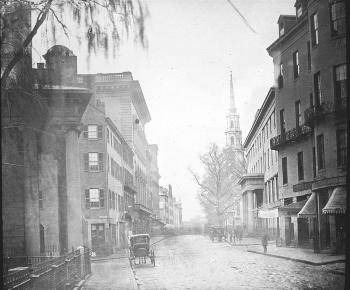
As a child, Sullivan enjoyed leisure and disliked work. He was unhappy at primary school, but enjoyed wandering the streets of Boston, later dating his decision to become an architect to this period in his life. On one outing, Sullivan saw a well-dressed man, clad in top hat and coat, exit a building. Determining that the man was important, Sullivan asked a workman about him and was told that he was the architect of the structure being built. Sullivan, prior to this, had looked at buildings with little awareness of their design and was astonished by the idea that a man, in his word, "could make up a building out of his head." He told his father of his plans and his father suggested, instead, that he become a farmer. Sullivan, despite clinging to the idea of being an architect, enjoyed spending summers at his grandparents' farm and was disappointed when his father forced him, from 1863, to work with him at his summer dancing school, hoping to instill strength and discipline in his son.
When Sullivan was a teenager, his mother's health began to decline, leading his parents to move to Chicago for medical care in 1869, leaving their younger son with his grandparents to attend high school in Boston. In 1871, Sullivan's grandmother died and his grandfather left for Philadelphia, leaving the teenager to live with neighbors in Boston for the next two years. While this arrangement was intended to allow Sullivan to finish high school, the son of the family with whom he lived was studying engineering at the Massachusetts Institute of Technology. He encouraged Sullivan to leave high school and enroll to study architecture at MIT.
article_text
Early Training
Sullivan enrolled at MIT in September of 1872, at age sixteen. He was among the youngest and most inexperienced students at the architecture school, but persisted, learning the fundamentals of drawing and design from teachers William Ware and Eugène Letang. Sullivan, however, quickly grew dissatisfied with the program and decided to leave MIT after his first year of study.
Still intent on becoming an architect, Sullivan decided to gain practical experience with the intention of later enrolling at the famous École des Beaux Arts in Paris. In order to gain experience, he moved to Philadelphia to live with his grandfather and introduced himself to Frank Furness, whose buildings he admired. Sullivan persuaded Furness to give him a trial which led to a few months' work with Furness, ending in November of 1873.
After this, Sullivan moved to Chicago to stay with his parents. He was immediately fascinated by the city, which was rapidly developing after the Great Chicago Fire of 1871. He began a six-month term of employment with the architect Major William LeBaron Jenney and met John Edelmann, a fellow architect who would become a lifelong friend.
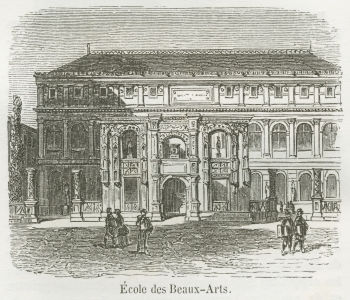
In 1874, feeling that he had gained enough practical experience, Sullivan left for France, where he spent his first six weeks studying for the entrance exams to the École des Beaux Arts, which he passed, allowing him to immediately enroll. In Europe, Sullivan gave up his North American style, exchanging his flannel suit and canvas shoes for a top hat, tails, glove and cane. He enjoyed Paris, but once again grew frustrated with life in an educational institution, preferring to learn through practice.
Mature Period
Sullivan left Paris in 1875, returning to Chicago, where he worked as a freelance draftsman and designer. John Edelmann introduced him to Dankmar Adler, a prominent architect known for his skill in managing client relationships and engineering acoustics. Adler hired Sullivan in 1879. The pair immediately worked well together and, in 1880, Adler asked Sullivan, who was only twenty-four, to be his partner.
Adler & Sullivan quickly developed a reputation as a top architecture firm in Chicago. In the first few years of their partnership, the firm were responsible for numerous office buildings, theatres and private residences. It was as a designer of office buildings, particularly, that Sullivan began to make a name for himself, becoming known for his ornate exterior designs and wide windows.
It was, however, Chicago's Auditorium, in 1889, which proved the pair's first major achievement. This project, however, was strenuous and Sullivan fell into ill health. In need of revivification, Sullivan took a trip around the United States, travelling to California, Louisiana and Mississippi. His last destination, Ocean Springs, in Mississippi, proved so much to his liking that he bought land there, designing and building himself a vacation home.
Upon return, Sullivan threw himself into his work with renewed vigor. The firm designed around forty buildings between 1890 and 1895. Sullivan's projects included the Wainwright Building, built in St Louis, Missouri - this 1891 structure, which developed Sullivan's ideas about office buildings and ornament, is widely considered as the first tall building to celebrate verticality in its design. The Wainwright Building cemented Sullivan's position as one of the foremost architects in the United States and later earned him the moniker of "Father of Skyscrapers."
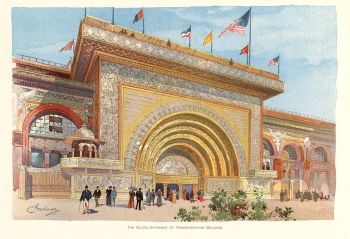
Adler & Sullivan continued their success with the Transportation Building for the 1893 World's Columbian Exposition in Chicago. Sullivan's building, which attracted attention through its golden doors beneath an imposing Romanesque arch, won three medals, more than any other architect who had been commissioned for the Exposition, and secured his position as a great ornamentalist. The Transportation Building was popular with critics in both the United States and Europe, but the public preferred the classically designed pavilions that surrounded it, which influenced the subsequent Renaissance Revival in North America. Sullivan, who saw these buildings as erasing architectural progress in America, credited the fair with changing taste such that his own career began to dwindle, closing his memoir, published in 1924, with an indictment of its architecture.
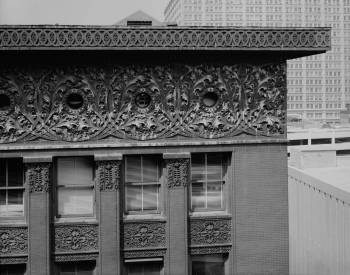
As the firm's success continued, Adler & Sullivan took on a number of young associates who would play a significant role in continuing Sullivan's work and developing American architecture, including Frank Lloyd Wright in 1887 and George Elmslie in 1888. Wright learnt a great deal from his period working under Sullivan and personally admired him, later stating that "the deep quiet of his temper had great charm." William L. Steele, though, another associate who worked under Sullivan, complained that he was a difficult person to work under, due largely to his severe and uncompromisingly high standards; he permitted no sloppiness and demanded a great deal of time from draughtsman. Frank Lloyd Wright, despite his admiration, found it difficult to work with him and left the studio in 1893, though the pair resumed their friendship later in life. Elmslie, who continued to work with Sullivan until 1908, played a significant role in developing the ornamentation for which his buildings are known.
Late Period
The last decades of Sullivan's career were markedly less successful. The Panic of 1893 resulted in a sharp decline in building commissions across the United States. In 1895, Dankmar Adler announced that he was retiring, further disrupting the firm. Sullivan was distressed at Adler's departure, refusing to let him rejoin the firm when he desired to do so one year later. Adler instead worked with his sons for the rest of his life and their friendship was never renewed.
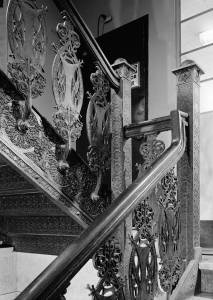
Sullivan's first job after the dissolution of the firm was for the Bayard Building, in New York City, in 1897; after this, he worked on banks across the Midwest. With less work than with Adler, Sullivan published weekly articles on architecture, entitled Kindergarten Chats, during 1901 and 1902. Sullivan's difficult personality became increasingly pronounced, with the architect developing a reputation for refusing to consider clients' wishes. As his commissions continued to dwindle, Sullivan began to auction off his books and household items in order to pay the rent on his office.
Sullivan's work occupied the bulk of his life and little is known about his personal life, particularly in later years, which were not covered in his memoir. He married Margaret Hattabough in 1899. Their marriage was reportedly respectful and Sullivan admired his wife, but the pair, according to Hugh Morrison, "lived in different spheres." The pair had no children and divorced in 1917.
Sullivan devoted his last years to writing a memoir, entitled The Autobiography of an Idea, which was published in 1924 alongside nineteen plates illustrating his ideas on ornament gathered under the title 'System of Architectural Ornament.' These two works were successful, but Sullivan, now sixty-seven, fell ill soon after their publication. He died of neuritis and a weak heart in April of 1924. He was buried in Graceland Cemetery, where he had designed three mausoleums for wealthy clients earlier in his career; as Sullivan's estate was depleted by his death, a fundraising campaign was run in order to facilitate his burial.
The Legacy of Louis Sullivan

Louis Sullivan's central tenet, "form follows function," went on to guide the development of modern architecture and design in the United States. Sullivan's influence is most obvious in his pioneering and perfecting of the skyscraper as a form but can also be felt in the development of ornament. He was a central figure in both the Chicago School of Architecture and the Prairie School and his aesthetic influence can be seen in the designs of those who worked under him at Adler & Sullivan, prominently including Frank Lloyd Wright, Marion Mahony Griffin, and Thomas Tallmadge.
Sullivan remains, however, unique in a number of ways. The popularity of Renaissance Revival architecture meant that he spawned fewer copycats that might otherwise have been the case. His skill in ornamentation, too, was such that few after him could match it, save those who were, at Adler & Sullivan, charged with executed it, such as George Elmslie.
Influences and Connections

- Dankmar Adler
- John Edelmann
- Frank Furness
- Major William LeBaron Jenney
- Eugène Letang
- André Bouilhet
- Lewis Mumford
-
![Art Nouveau]() Art Nouveau
Art Nouveau - Japanese art
- Neo-Gothic Style
- Romanesque architecture
-
![Frank Lloyd Wright]() Frank Lloyd Wright
Frank Lloyd Wright - Dankmar Adler
- Max Dunning
- John Edelmann
- George Elmslie
- André Bouilhet
- Paul Bourget
- Lewis Mumford
-
![Art Nouveau]() Art Nouveau
Art Nouveau -
![Art Deco]() Art Deco
Art Deco -
![Interwar Classicism]() Interwar Classicism
Interwar Classicism - Chicago School of Architecture
- Prairie School of Architecture
Useful Resources on Louis Sullivan
- Kindergarten Chats and Other WritingsOur PickBy Louis Sullivan
- The Autobiography of an IdeaOur PickBy Louis Sullivan
 Ask The Art Story AI
Ask The Art Story AI